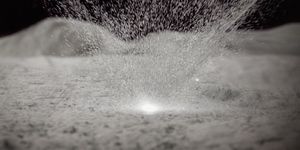Shielding Europa Clipper: NASA's Armor Against Jupiter's Menacing Radiation
As NASA’s Europa Clipper is being prepped for its October 2024 launch date, engineers at NASA’s Jet Propulsion Laboratory (NASA JPL) are scrambling to ensure the spacecraft has everything it needs to achieve a successful mission, including giving it the proper shielding to protect it from Jupiter’s extremely harsh radiation environment because of its massive magnetic field. This “armor” recently received its finishing touches on October 7, as JPL engineers sealed the 1-centimeter (0.39-inch) thick vault built to protect Europa Clipper’s cultivated suite of electronics designed to search for potential habitability on the Jupiter’s second Galilean moon, Europa.
Oct. 7 image of JPL engineers and technicians sealing the NASA Europa Clipper spacecraft’s vault in the main clean room of the JPL Spacecraft Assembly Facility. The vault is designed to shield the elaborative suite of electronics as Clipper orbits Jupiter throughout its mission. (Credit: NASA/JPL-Caltech)
“The vault is designed to reduce the radiation environment to acceptable levels for most of the electronics,” said Dr. Insoo Jun, who is an expert on space radiation, a Group Supervisor/Principal Scientist at JPL, and the co-chair of the Europa Clipper Radiation Focus Group.
As noted, Jupiter has a massive magnetic field, which is approximately 20,000 times as powerful as the Earth’s magnetic field. Without proper shielding, this could cause catastrophic damage to electronics on any spacecraft, effectively ending the mission. While Europa Clipper is planned to perform elliptical orbits that temporarily remove it from Jupiter’s radiation belts, the spacecraft needs to travel within the radiation belts to study Europa. Additionally, researchers hypothesize that Jupiter’s radiation belts are so intense that they alter the very surface of Europa, including changing its color, which could make for some very interesting science observations during the mission.
“Radiation on the surface of Europa is a major geologic modification process,” said Dr. Tom Nordheim, who is a planetary scientist and roboticist at JPL, and an expert on icy moons. “When you look at Europa – you know, the reddish-brown color – scientists have shown that this is consistent with radiation processing.”
As noted, Europa Clipper will be investigating the potential habitability of the small moon, primarily within its vast ocean underneath is icy crust, and ocean that potentially contains double the water as the Earth.
How will this vault help protect Europa Clipper from Jupiter’s harsh radiation belts, and what will Europa Clipper teach us about this small moon in the coming years and decades? Only time will tell, and this is why we science!
As always, keep doing science & keep looking up!
Sources: NASA, NASA JPL, NASA (1), University of Colorado at Boulder, NASA (2)









